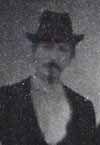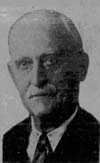A number of men who survived the Battle of the Little Bighorn were killed fifteen months later on September 30, 1877, during the battle at Snake Creek, Montana.
- James H. Alberts
- David Edward Dawsey
- Otto Durselew
- Owen Hale
- George M. McDermott
- Max Mielke
- Henry W. Raichel
- William J. Randall
- Francis Roth
- William Whitlow
James Montgomery Bell was born on October 1, 1837, in Williamsburg, Blair County, Pennsylvania. He was the First Lieutenant for Company D who was not present at the Battle of the Little Bighorn because he was on leave.
Joseph Milton died in Tillsonburg, Ontario, Canada, on October 1, 1904. He was a Private in Company F who was not present at the battle due to detached service.
Wilbur F. Blair died on October 2, 1891, in Lewisburg, Pennsylvania, and was buried there in the Lewisburg Cemetery. He was a Private in Company A who participated in the valley and hilltop fights.
Patrick Carey died in Washington, D.C., on October 3, 1893, and was buried in the Soldiers’ Home National Cemetery there. He was a Sergeant in Company M who participated in the valley and hilltop fights.
Frank Braun died on October 4, 1876, at Fort Abraham Lincoln, Dakota Territory, during an operation on the gunshot wounds he received during the battle. He was a Private in Company M who participated in the valley fight and was wounded in the face and left thigh during the fight on Reno Hill. He was originally buried at the Fort Abraham Lincoln Cemetery but was later reinterred in the Custer National Cemetery on Crow Agency, Montana.
 Abram B. Brant (left) died at Camp J. D. Sturgis, Dakota Territory, on October 4, 1878, from a gunshot wound to the abdomen and was buried at Fort Meade National Cemetery. He was a Private in Company D who participated in the hilltop fight. He was awarded the Medal of Honor posthumously one day after his death for his actions on Reno Hill.
Abram B. Brant (left) died at Camp J. D. Sturgis, Dakota Territory, on October 4, 1878, from a gunshot wound to the abdomen and was buried at Fort Meade National Cemetery. He was a Private in Company D who participated in the hilltop fight. He was awarded the Medal of Honor posthumously one day after his death for his actions on Reno Hill.
Black Fox died on October 5, 1936, and was buried in the Holy Family U. S. Scouts Cemetery in Sanish, Mountrail County, North Dakota. He was an Arikara Scout who was not present during the battle.
 Jacob Horner (right)was born in New York City on October 6, 1855. He was a Private in Company K who was not present during the battle due to detached service.
Jacob Horner (right)was born in New York City on October 6, 1855. He was a Private in Company K who was not present during the battle due to detached service.
